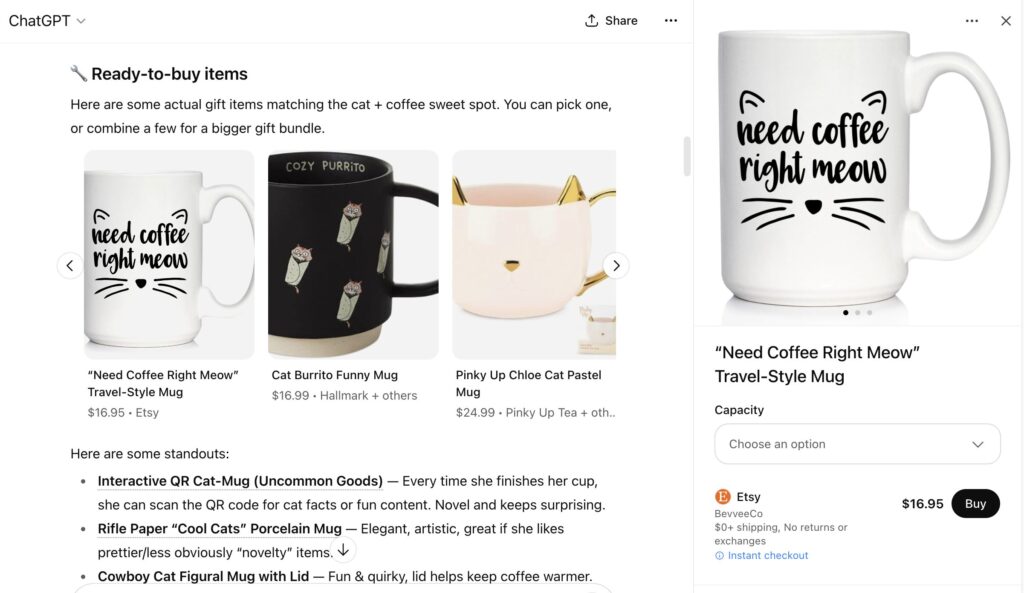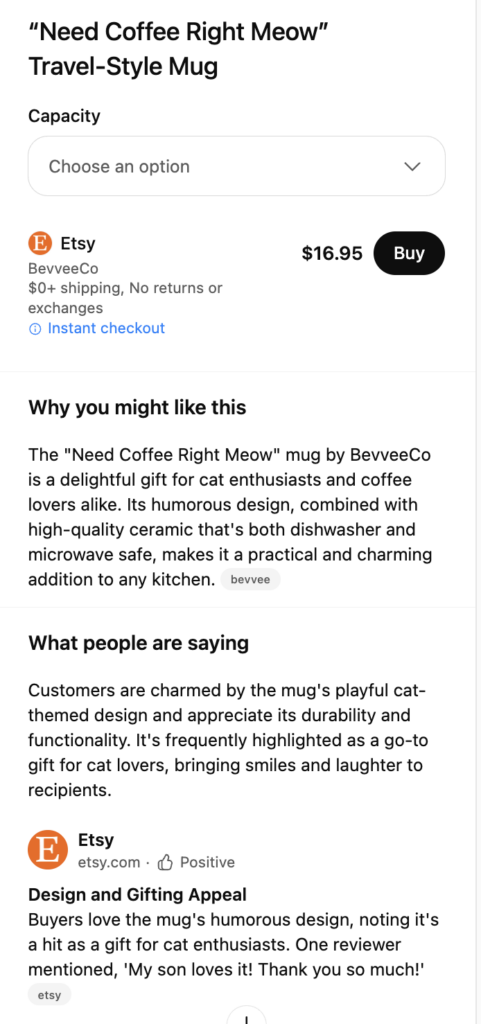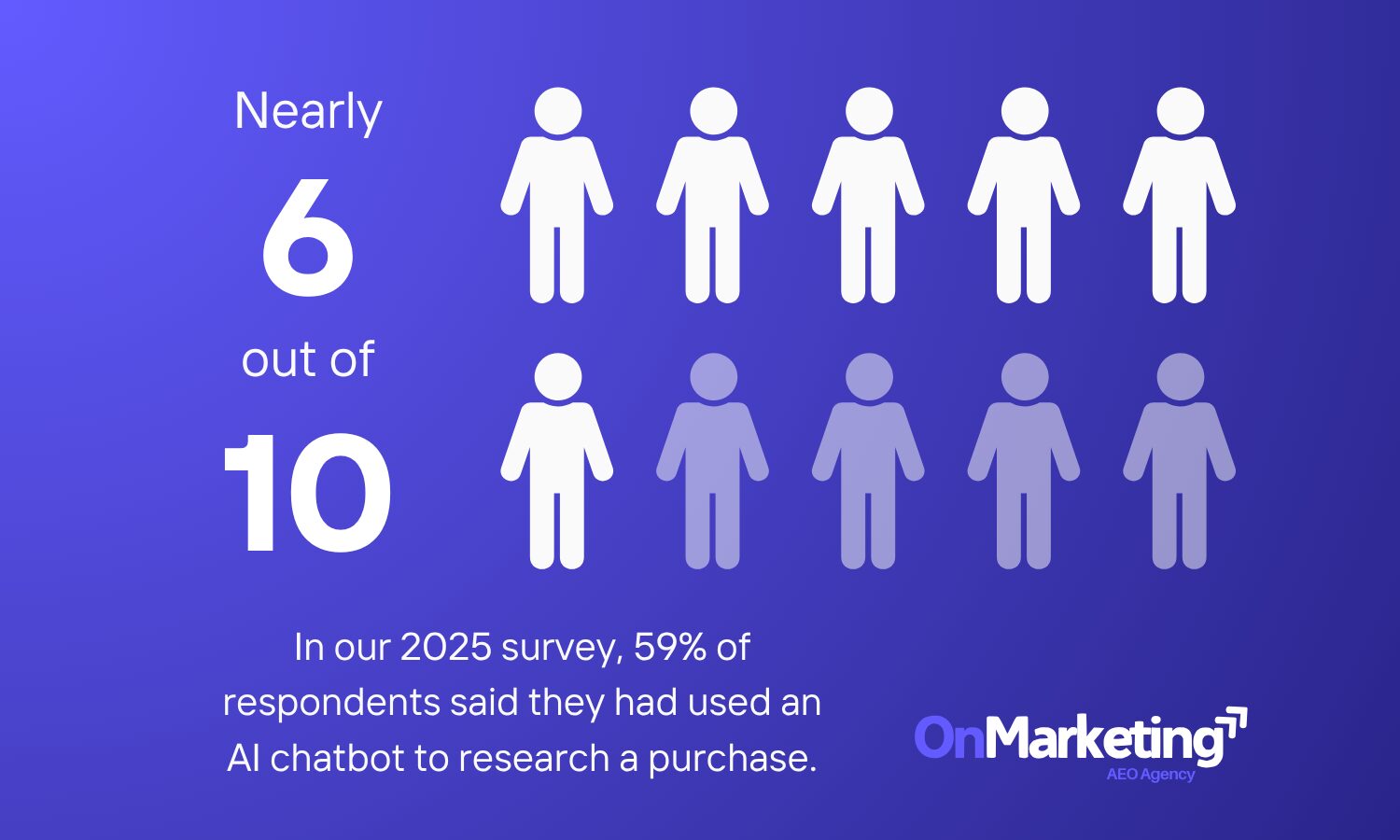Answer engine optimization (AEO) is one of the most important marketing strategies for the new instant checkout feature in ChatGPT.
ChatGPT has been recommending products for a while, but in September, OpenAI announced its new ChatGPT Instant Checkout feature. Now shoppers can buy some of the products ChatGPT suggests without even leaving the chat.
Will people use it? We think so. On Marketing recently surveyed 250 consumers in the U.S. about their use of ChatGPT and other LLM-powered chatbots. We wanted to know whether they had ever used ChatGPT, Microsoft Copilot, Perplexity, Gemini, or another AI chatbot to research a purchase. Nearly 6 out of 10 (59%) said they had used an AI chatbot to make a decision about a purchase. Most of them, or 57.6%, had used a chatbot for a consumer purchase. A good portion (12.4%) had used a chatbot for a business purchase. You can see our full 2025 AEO trends report for more results.
This should be a wake-up call to anyone marketing or selling consumer products. While Instant Checkout is starting with Etsy sellers, OpenAI says they will roll it out to other merchants soon. B2B marketers should pay attention, too, since businesses could start making purchases in a similar way.
What is ChatGPT Instant Checkout?
ChatGPT Instant Checkout lets users buy products directly in the chat interface, without following links. It runs on the Agentic Commerce Protocol, which is an open standard that OpenAI and Stripe built to facilitate purchases between buyers, AI agents (like ChatGPT), and businesses selling products.
From the user end, this experience feels pretty seamless. Let’s say your friend is turning 40 and you’ve got five minutes to find a thoughtful gift. You tell ChatGPT that she likes cats and coffee.

After offering a few suggestions—a visit to a cat cafe, a coffee of the month club, personalized art of her cats—ChatGPT shows some ready-to-buy items. They’re right on the mark: coffee mugs with a cat theme. The prices and vendors are clearly visible, and clicking on an item triggers a pop-up with more details and a button to visit the retailer.

Etsy products show up with an extra feature: an “Instant checkout” label and a buy button. Hovering over the label gives you this message:
Instant checkout helps you order directly from merchants in ChatGPT. Merchants may pay a fee when you buy, but it’s free for you and your product recommendations aren’t affected. Merchant rankings consider checkout availability, seller type, price, and inventory.
The message also has a link to more information about shopping with ChatGPT search to explain how it works.
Clicking the buy button triggers a pop-up that lets you choose the quantity and method of payment, including Apply Pay or any saved credit cards.
How does ChatGPT decide which products to show?
ChatGPT shows the products it thinks are the most relevant to your search intent. This is based on:
- Metadata from the retailer, including the product description and price
- Responses from ChatGPT’s foundational models, which are somewhat random by nature and can lead to different answers and product recommendations for the same question
- OpenAI’s standards for safety and product policies
Interestingly, OpenAI notes that product recommendations can be influenced by previous chats you’ve had with ChatGPT. For example, if you ask for dog costumes but have previously mentioned you don’t like clowns, it might leave clown costumes out of your results.
OpenAI says that the products ChatGPT recommends aren’t ads, and they’re not influenced by OpenAI partnerships.
How can I improve the chance of my product showing up in ChatGPT?
The best thing retailers can do is optimize their product descriptions for the questions customers might ask ChatGPT. The “Need Coffee Right Meow” mug does this well by mentioning that it’s a great gift for cat lovers. It does this without keyword stuffing; note that you don’t see “gift” anywhere in the product name, and that it’s mentioned only once in the product description. In fact, the product description doesn’t even need to say that it’s a cat-themed mug, since “meow” acts as a semantic keyword and helps ChatGPT understand that the product is related to cats.

This is just an extension of one of the core tenets of product marketing: ask yourself what type of customer buys your product and why.
- Is your product a good gift item? Make sure to mention “gift” in the description.
- Does your product appeal to a fan base? Use words like “enthusiast” and “lover.”
- How else would you describe your target customer? If they like indoor plants, you might mention that your product is great for people with a “green thumb.” If you’re selling a kit, it’s great for a “DIYer” or “crafter.”
- Is there a particular event or holiday your product might be perfect for? Mention that your turkey-themed serving tray is great for “hosting Thanksgiving” or as a “dish for stuffing.”
Because ChatGPT might pick certain items based on price, make sure you’ve priced your product strategically. You might have a disadvantage if you price at $52 when customers might be looking for options under $50.
Optimize for ChatGPT Instant Checkout in 5 steps
While you can’t pay OpenAI to recommend your products, you can help ChatGPT find and show them to customers by optimizing your product names, descriptions, and pricing.
If you have an Etsy shop, you are automatically set up for Instant Checkout. OpenAI will add other retailers soon, so be ready with an optimized description.
Step 1: Brainstorm your target customer
Who buys your product? Star Wars fans? Vegetable garden growers?
What’s their style? Do they like antique, hipster, or handmade items?
When do they buy your product? For a birthday, to celebrate an event, to decorate for a holiday?
Where are they? Would your bird bath be fun to watch on a rainy Oregon day? Is your tote bag perfect for Disneyland?
Why do they want to buy your product? As a gift? To show off their fandom?
Step 2: Write some questions your customer might ask ChatGPT
Based on your brainstorm above, write a list of questions you think your target customer might ask ChatGPT. For example:
What are some party games I can play with my family at Thanksgiving?
What are some unique gifts I can give my nephew? He’s 8 and loves the Seahawks.
How should I pack for a trip to Portland in January?
What’s the best way to organize my spice cabinet?
Step 3: Pick a few search terms
Take your ChatGPT questions to your favorite keyword tool and research short phrases, one at a time. Sort them based on search volume and keyword difficulty.
Pick one primary search term and no more than a few others to support it. If your tool suggests semantic keywords, get a list of those to sprinkle throughout your product description.
You can also go to Google and use the “People Also Ask” feature to find popular questions related to your product.
Step 4: Write your product name and description
Write an original product name that describes the item while hinting at who or what it’s for. You don’t necessarily need to use your primary keyword here, although it could help. Think along the lines of “Grandma’s old-fashioned cranberry sauce serving dish” or “Funky dog sweater with peace symbols.”
Next, write a product description that includes your keywords and any other context you can give about the who, what, when, where, and why you explored above. Imagine that you’re answering the ChatGPT questions you wrote above, and be descriptive: “This customizable jersey will make you the cool aunt or uncle for your football-loving niece or nephew.”
Step 5: Pick the right price
Don’t filter yourself out of search results with a price that goes just a dollar or two above a round number. Think about the target prices that people might search for: $25, $50, $100.
Do some research by asking ChatGPT to recommend products like yours, and see how your competition prices their items.
Watch for more e-commerce merchants to adopt the Agentic Commerce Protocol
As always with anything AI, things are changing quickly between ChatGPT and e-commerce platforms. Keep your eye on opportunities to align with the Agentic Commerce Protocol, and get ready for what’s next by optimizing your product descriptions for AI answer engines.
For more about how marketing teams are optimizing for LLM search, see our Trends in Answer Engine Optimization (AEO) 2025 Report.

